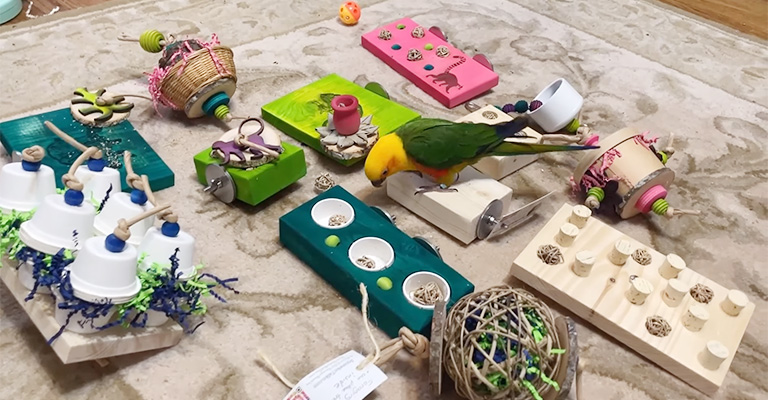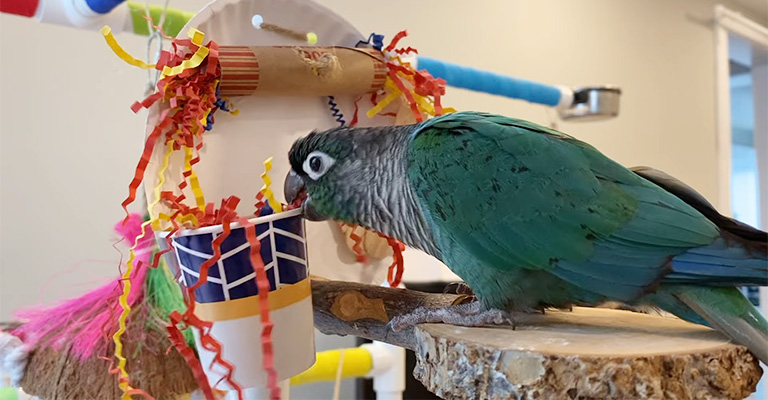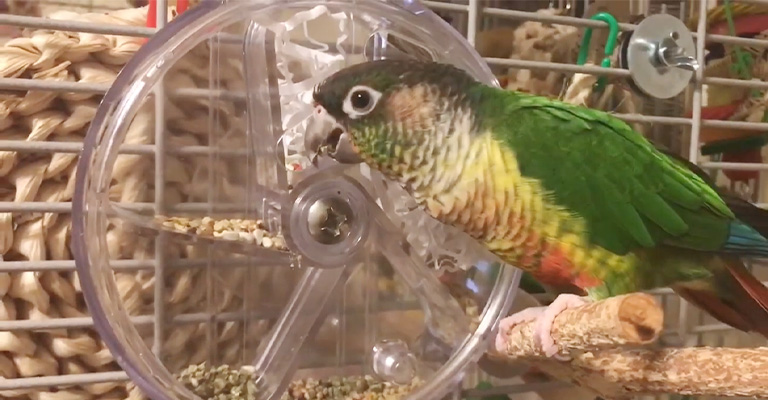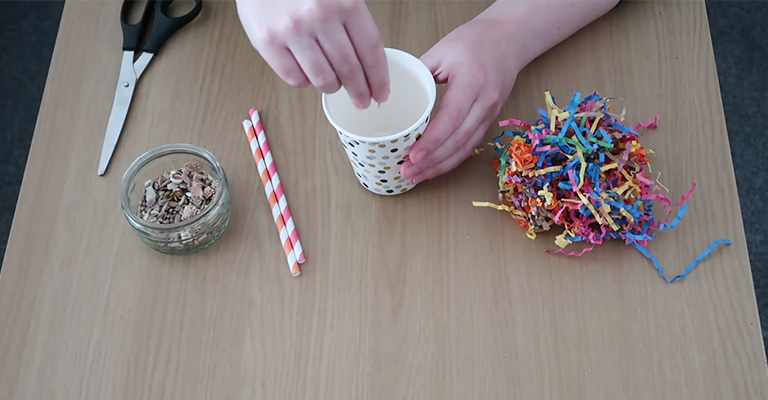Parrots are not just colorful and charismatic birds; they are highly intelligent and curious creatures. To keep them happy and healthy in captivity, it’s crucial to stimulate their minds and bodies. One of the most effective ways to achieve this is through foraging.
In the wild, parrots spend a significant portion of their day searching for food, a behavior that engages their problem-solving skills and keeps them physically active.
Captive parrots, however, often miss out on this vital aspect of their natural behavior. This blog post will explore a variety of foraging ideas and activities that you can introduce to your feathered friend’s daily routine.
From homemade foraging toys to using fresh fruits and vegetables, we’ll delve into ways to keep your parrot mentally and physically engaged. By incorporating these foraging ideas, you’ll provide your parrot with essential enrichment and enhance their overall well-being. Stay focused.

What Is Foraging for Parrots?
Foraging for parrots is a stimulating and natural behavior that involves searching for food in an environment, mimicking their wild counterparts’ hunting and gathering instincts. It’s an essential aspect of their mental and physical well-being.
In captivity, providing opportunities for parrots to forage can improve their cognitive abilities, reduce boredom, and prevent behavioral issues.
Parrot foraging can be facilitated through various methods, such as hiding food in toys, wrapping it in paper, or placing it in puzzle feeders. These activities encourage problem-solving and keep the birds engaged, promoting both physical and mental exercise.
Foraging for parrots is an enriching and rewarding activity that contributes to their overall health and happiness by stimulating their natural foraging instincts and providing mental stimulation.
Effective Foraging Ideas for Parrots

Effective foraging ideas for parrots can help keep them mentally and physically stimulated. Here are some creative and engaging foraging ideas:
Foraging Toys
Invest in commercial foraging toys designed for parrots. These toys often have compartments or puzzles that hide treats or food. Parrots must manipulate the toy to access the rewards.
Paper Shredding
Provide your parrot with plain, non-toxic paper that they can shred to find hidden treats. You can wrap treats in the paper or stuff them into cardboard tubes for added complexity.
Hide and Seek
Conceal small treats or food items around their cage or play area. Make sure the hiding spots are safe and accessible. Parrots enjoy the challenge of finding hidden treasures.
Forage Boxes
Create foraging boxes filled with materials like safe wood, paper, or straw. Hide treats within these materials to encourage exploration.
Puzzle Feeders
Use puzzle feeders designed for dogs or cats and adapt them to your parrot’s size. These interactive feeders can make mealtime more engaging.
Natural Branches
Attach fresh, pesticide-free branches with leaves or flowers to the cage. Parrots can chew on them, find insects, and enjoy a more natural foraging experience.
Fruit and Veggie Kabobs
Skewer small pieces of fruits and vegetables onto a stainless steel kabob. This adds an element of challenge and encourages healthy eating.
Egg Carton Foraging
Place treats or pellets in the compartments of an empty, clean egg carton. Parrots can flip it open to access the rewards.
Foraging Baskets
Hang baskets filled with safe foraging materials like vine balls, palm leaves, or even small wooden blocks. Hide treats among these items.
Scavenger Hunts
Create mini scavenger hunts by hiding treats or toys in various spots around the room. Allow your parrot to explore and discover.
Remember to monitor your parrot during foraging activities, especially if they are new to the concept. Ensure that all materials used are safe and non-toxic.
Benefits of Foraging for Parrots

Foraging offers several significant benefits for parrots, both in the wild and in captivity:
Mental Stimulation
Foraging engages a parrot’s cognitive abilities as they problem-solve to access food. This mental stimulation helps prevent boredom and the development of behavioral issues often seen in captive parrots.
Physical Exercise
The act of searching for food encourages physical activity. Climbing, reaching, and manipulating objects during foraging provide essential exercise, promoting overall fitness and preventing obesity.
Emotional Well-Being
Foraging mimics the natural behavior of seeking food in the wild, promoting a sense of fulfillment and reducing stress in parrots. It can alleviate boredom and frustration, leading to a happier and healthier bird.
Natural Instinct Satisfaction
Parrots have a strong instinct to forage for their food in the wild. Providing opportunities for foraging allows them to express this natural behavior, contributing to their overall well-being.
Improved Problem-Solving Skills
Foraging puzzles and toys challenge a parrot’s problem-solving abilities. Over time, they become more adept at manipulating objects and finding hidden treats, enhancing their cognitive development.
Reduced Aggression
Parrots that engage in foraging activities are less likely to exhibit aggressive behaviors. The mental and physical stimulation provided by foraging can redirect their energy away from destructive actions.
Healthy Eating Habits
Foraging encourages parrots to eat a variety of foods, including fruits, vegetables, and pellets, promoting a balanced diet and preventing selective eating habits.
Social Interaction
Some foraging activities can be shared with other parrots or with their human caregivers. This promotes social interaction and strengthens the bond between parrots and their owners or cage mates.
Enrichment
Foraging adds enrichment to a parrot’s daily routine. Novelty and variety are essential for their mental and emotional well-being, and foraging provides these elements.
Longevity
The mental and physical benefits of foraging can contribute to a longer and healthier life for parrots, as they are less prone to obesity and related health issues.
So, foraging is a vital aspect of parrot care, offering numerous physical, mental, and emotional advantages. It not only keeps parrots physically fit but also satisfies their natural instincts and enhances their overall quality of life in captivity.
Things to Consider While Foraging a Parrot

When foraging for a parrot, there are several important factors to consider to ensure the safety and effectiveness of the activity:
Safety of Materials
Use only safe, non-toxic materials and food items. Avoid materials treated with chemicals, paints, or dyes that could harm your parrot.
Size and Complexity
Choose foraging toys and activities appropriate for your parrot’s size and skill level. Gradually increase the complexity as your parrot becomes more experienced.
Supervision
Initially, monitor your parrot during foraging activities to ensure they understand and can safely engage with the materials and toys.
Variety
Offer a variety of foraging opportunities to keep your parrot engaged and prevent boredom. Change up the types of puzzles, toys, and hiding places regularly.
Nutritional Balance
Ensure that the treats or food items hidden for foraging are part of a balanced diet. Avoid overloading on high-sugar or high-fat treats.
Cleanliness
Keep foraging materials and toys clean and free from mold or spoiled food. Regularly inspect and clean items to maintain hygiene.
Enrichment
Make foraging a part of your parrot’s daily enrichment routine. It should complement other activities and environmental stimuli.
Supervision During Outdoor Foraging
If you allow your parrot to forage outdoors, do so in a safe, enclosed space to prevent escape or exposure to hazards. Always supervise outdoor foraging.
Time and Patience
Some parrots may take time to adapt to foraging. Be patient and provide encouragement as they learn to engage with foraging toys and activities.
Safety Precautions
Be mindful of any potential hazards in your parrot’s environment while foraging. Remove items that could be harmful or toxic.
Social Interaction
Foraging can also be a social activity. Consider involving other parrots or interacting with your bird during foraging sessions to strengthen bonds.
Age and Health
Take your parrot’s age and health into account. Older or less agile birds may require simpler foraging challenges, while younger, more active birds can handle greater complexity.
Regular Rotation
Rotate and refresh foraging items and challenges regularly to maintain your parrot’s interest and prevent them from becoming too accustomed to specific routines.
By considering these factors, you can create a safe, engaging, and effective foraging experience for your parrot that contributes to their physical and mental well-being while ensuring their safety and health.
Tips for Successful Foraging
Successful foraging for your parrot involves creating engaging and stimulating experiences while ensuring their safety and well-being. Here are some tips for a successful foraging experience:
Start Simple
If your parrot is new to foraging, begin with straightforward challenges that are easy to solve. Gradually increase the complexity as they become more skilled.
Choose Appropriate Materials
Select foraging toys, puzzles, and materials that are safe and suitable for your parrot’s size and species. Avoid toxic or hazardous items.
Balanced Diet
Use a mix of your parrot’s regular diet and special treats for foraging. Ensure that the foraging items contribute to a balanced diet.
Rotate Toys
Regularly rotate and introduce new foraging toys to prevent boredom and maintain interest. Parrots can become accustomed to the same challenges over time.
Location Matters
Place foraging opportunities strategically around your parrot’s environment. This encourages exploration and keeps them physically active.
Supervision
Initially, supervise your parrot during foraging to ensure they understand the activity and can do it safely. Provide guidance and encouragement as needed.
Variety of Textures
Include a variety of textures in foraging materials, such as wood, paper, fabric, and natural materials like branches or palm leaves.
Time of Day
Parrots are often more active and alert during certain times of the day. Schedule foraging activities when your parrot is most engaged, which may vary by species.
Social Foraging
Encourage social interaction during foraging by involving other parrots or interacting with your bird during the activity. This can strengthen bonds and provide mental stimulation.
Consistency
Incorporate foraging into your parrot’s daily routine to make it a consistent part of their enrichment and mental stimulation.
Problem-Solving Challenges
Increase the complexity of foraging challenges as your parrot becomes more experienced. This encourages problem-solving and critical thinking.
Positive Reinforcement
Use positive reinforcement, such as praise or treats, to reward your parrot when it successfully completes a foraging task. This reinforces the behavior.
Outdoor Foraging
If you allow your parrot to forage outdoors, ensure they are in a secure, enclosed area, free from potential dangers. Supervise outdoor foraging closely.
Patience
Be patient with your parrot as they learn to forage. Some birds may take time to adapt, while others may pick it up quickly.
Observe and Adapt
Pay attention to your parrot’s preferences and abilities. Adapt your foraging challenges based on what engages and stimulates them the most.
Successful foraging not only provides mental and physical stimulation for your parrot but also enriches their daily life, contributes to their well-being, and helps prevent boredom and behavioral issues.
FAQs
Safe materials include untreated wood, natural fibers like sisal or palm leaves, and non-toxic paper. Avoid materials with paints, dyes, or chemicals that could harm your parrot.
Increase the complexity by adding layers or compartments, using smaller openings, or incorporating moving parts. This encourages problem-solving and mental stimulation.
Yes, fresh fruits and vegetables are excellent foraging options. Skewer them on safe metal kabobs or hide them in foraging toys to encourage healthy eating habits.
Yes, especially when introducing new foraging challenges. Supervision ensures your parrot’s safety and helps them understand how to interact with the toys or materials safely.
Rotate and introduce new foraging opportunities regularly, ideally every few days. This prevents boredom and keeps your parrot mentally engaged with novel challenges.
Wrapping Up
Foraging isn’t just a pastime for parrots; it’s a necessity for their mental and physical health. As responsible parrot owners, we hold the key to unlocking this enrichment opportunity.
By implementing the foraging ideas discussed in this blog post, you can mimic their natural behaviors, reduce stress, and provide an avenue for exercise. Remember, it may take time for your parrot to adjust to these new activities, so be patient and offer guidance.
In return, you’ll be rewarded with a happier, healthier, and more mentally stimulated feathered companion. Embrace the world of foraging for parrots, and watch your beloved bird flourish in an enriched environment. Best of luck.